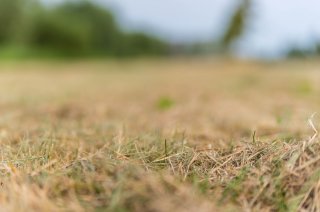
category_news
Dry grass? Leave it alone, and it will recover
Long dry spells are increasingly common in the Netherlands. What should farmers do if their meadows become dry? Bert Philipsen, animal nutrition expert at Wageningen Livestock Research, recommends doing nothing. If it is not damaged, it will recover.
Plants reduce their evaporation during a drought. Trees shed their leaves, and the grass curls up and becomes yellow. It is not dead but hibernating. ‘As long as the shoot remains alive, the grass will recover’, says Philipsen. ‘As soon as there are sufficient fluids, it will start growing again.’ But in the meantime, it is best to leave the dry grass alone. ‘If the grass is very desiccated, it will break simply by walking on it, and that thwarts any chances of recovery.’
Grass on sandy soils is the most vulnerable
‘Many meadows are covered in English rye grass’, Philipsen explains. ‘That type of grass is extremely resilient. One plant per ten square centimetres is sufficient to achieve a full soil coverage.’ The English ryegrass is relatively deep-rooting, which increases its chances of survival. Other grasses may have more difficulties.
Philipsen and his colleagues from Wageningen study herb-rich grasses at the De Marke Agro-innovation centre. ‘The herb-rich meadows with resilient grasses and legumes and herbs are still looking fresh right now. But these meadows, too, require rest during times of drought. After a lengthy period of drought and heat, almost every plant will suffer from drought stress.’
‘The type of soil is very important in determining the grass’ capacity to recover’, Philipsen says. ‘The grass roots relatively deeply in clay soils, which means it has access to more water. Moreover, the groundwater is not very deep, and there is a capillary supply, which enables water to creep up through the spaces in between the soil particles. Peat soils are also water-laden, but the surface can dry out more easily than clay. Sandy soils present the highest risks. Not only is groundwater located at a significant depth, but it may also cause incineration damage. ‘It is as if the sprout is burned by the sunlight reflected by the sand.’
How badly is the dairy sector affected by the drought?
During the extremely dry year of 2022, the wet spring of 2023 and the subsequent period of extreme drought, the grasslands and feed supply were significantly impacted. And some dairy farmers are sure to be affected, Philipsen predicts. ‘I expect that the water supply, the humidity, and soil quality will play an increasingly crucial role in the future. Where you farm and how much moisture is available makes an increasing difference.’
Dry spells also affect the way the farm is run. Allowing cattle to graze is more difficult, and spreading our manure is pointless. ‘The grass does not need manure. However, sufficient manure must be applied to the land before 1 September since storage must be available for manure during the winter.’ This may well become a bottleneck as it has been in the past few years, according to Philipsen.
How can farmers manage dry grass?
Grassland needs sufficient water in the spring. Dairy farmers may take additional measures to increase water retention, for example, by creating dams. This may be supplemented by sprinkling. Philipsen: ‘Dutch farmers use surface water and their own wells for sprinkling, and hence do not impact the supply of drinking water.’ If the grass on sandy soils dies, recovery costs a lot of energy, while the use of minerals is lower, which ‘has an additional adverse effect on the environment.’